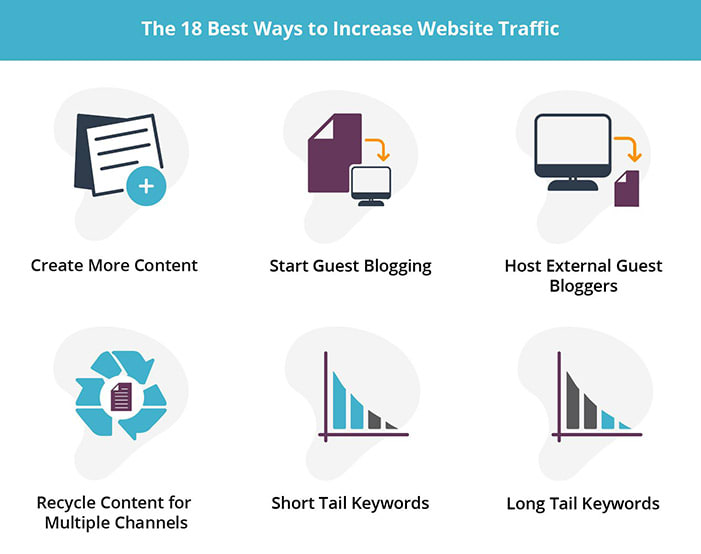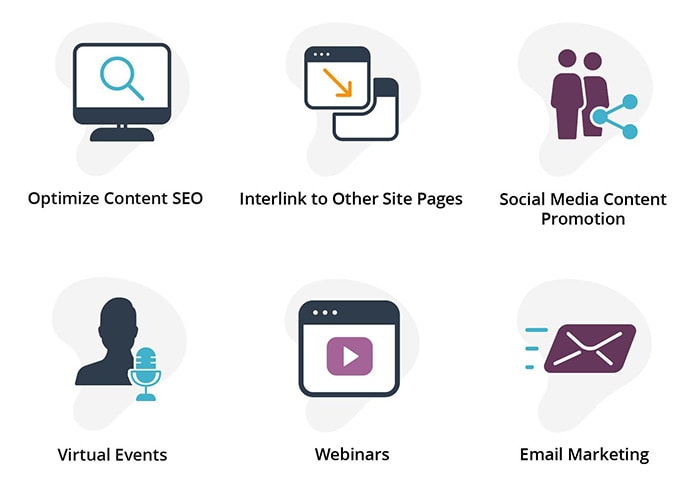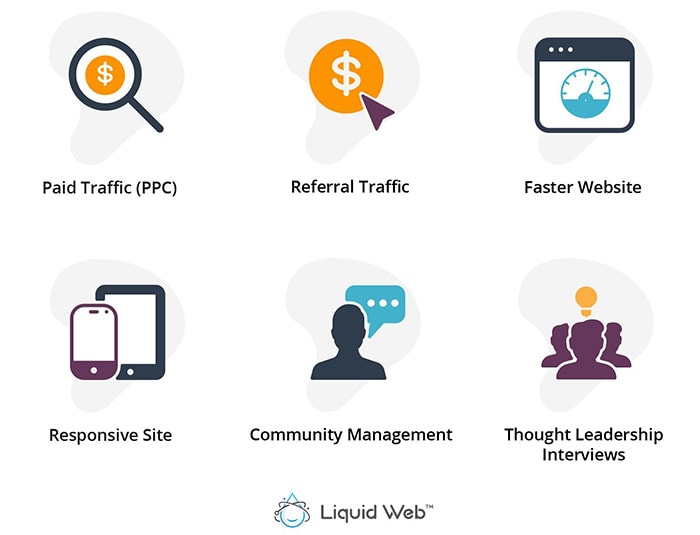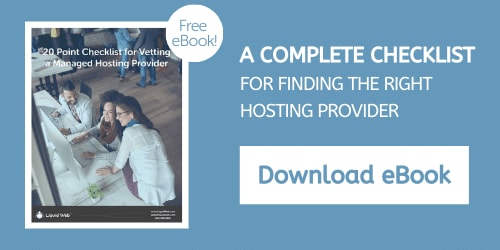
Interested in how to increase website traffic?
You have a website, you’re blogging and creating content, but the needle isn’t moving as fast as you would like. Your boss says he would like to see live chats and leads go up, which means you need more website traffic.
After all, the best way to increase revenue is to increase web traffic, which will increase the number of leads your sales team works. It’s a numbers game.
Here are the top 18 ways to drive more site traffic in 2021.
Table of Contents



1. Create More Content
The best way to generate web traffic is to create more content. What better way to jumpstart your content creation process than by utilizing inside experts already versed in the subject matter at hand? After all, your content team is probably already cranking out as much as they can.
Incentivize employees to write blogs or create videos about keyword-rich content designed to educate your target audience and watch your site traffic grow.
An internal guest blogging program will:
- Build brand equity while raising site rankings and visits
- Allow you to tap into experts and keyword-rich content not accessible anywhere else
- Decrease support tickets and arm sales with content designed to be helpful
- Provide more content that marketing can use in paid and organic social promotions
2. Start Guest Blogging
You can’t merely rely on your blog to support your website traffic initiatives. The best way to get new audiences is by guest blogging with reputable sites with similar target audiences. This will build immediate credibility with these audiences, expand your reach, and build backlinks along the way. And by becoming a perceived industry expert, you will gain more credibility.
3. Host External Guest Bloggers on Your Website
Open up your blog for reputable guest bloggers to post on your website. This is also a fantastic way to draw new readership, increase blog subscribers, and increase website traffic for your target audience. Invite key influencers in your industry to participate on your blog, and make sure the content is keyword-rich and makes sense for your audience. This is also a great way to get backlinks since the author will most likely want to link to their work on their site.
4. Recycle Content for Use Across Multiple Channels
If you are already pumping out new content such as blogs or videos, take your content creation and website traffic to the next level by recycling your existing content into new formats. After all, different audiences like to consume content in a variety of forms and on different platforms. And it’s much easier to recycle than to create brand new content.
- Create a video on how your product makes life easier and post to YouTube
- Transcribe your video audio into a blog post for your website (don’t forget to embed the video)
- Take creative from the video and copy from your blog to create an infographic
- Take the infographic and use it to create a short burst of social cards to promote organically on Twitter and Instagram
- Take the social card creative and make display ads to promote your products on Google
- Take the three most important points from the video and create a webinar to drive leads to marketing
With seemingly one piece of content, you can create endless variations of different formats for different platforms, all of which can drive site traffic. And the process will be much faster without the ideation or writing phases.
5. Blog For Short-Tail Keywords First
Develop a keyword strategy for your website, and then complement this strategy with a short-tail blogging keyword strategy that will drive traffic to your website and ultimately your products.
Blogging is one of the best ways to increase your site traffic because Google can more easily crawl content full of copy, rather than other types of content, such as infographics or videos. This makes it the optimal format to rank on search engines like Google, Bing, or Yahoo for keywords with high volumes.
Short-tail keywords are one to two words long and drive the most traffic. But they are also the most competitive, since everyone else will be trying to rank for them as well.
Short-tail keywords will be the most difficult to secure, as they require both site authority and content relevance to even have a chance to rank.”
Try to create pillar pages or long-form blogs for these keywords. Pillar pages are web pages that cover a subject in depth and breadth and contain a slew of links to resources of related content, which we will get to next.
6. Focus on Long-Tail Keywords
Once you have pillar pages, long-form blogs, and product pages that are created to rank for your website short-tail keywords, focus on creating long-tail keyword content for middle and bottom of funnel content.
Long-tail keywords are keywords four to six words in length and relate to specific questions that are searched by audiences on search engines.
For your long-tail keyword content, answer questions as completely as possible to rank. In fact, it’s best to check out the top-ranking articles and see what is being covered, and even more importantly, how you can cover the same subject more fully or with unique content they don’t have.
For instance, the top SERP (search engine results pages) result may cover the subject quite well but doesn’t contain any rich media, such as videos or infographics. This is an opportunity you have to usurp them by creating complementary media for your content.
7. Optimize Content SEO
Make sure every piece of content you create is optimized for search engine optimization (SEO). That means ensuring your title, meta description, and slug all contain your short or long-tail keyword. That also means you pay close attention to using supporting keywords to cover the topic in its entirety for the headers in your content.
Those using WordPress can use plugins such as Yoast SEO to provide helpful indicators of SEO-healthy content, or where improvement is needed.
And consider incorporating schema markup into your blogs and product pages to help Google and search engine visitors navigate your website more easily.
8. Interlink to Other Pages on Website
Google pays close attention to backlinks, as we all know. Backlinks are links that point from an external page or site back to yours, creating authority for your site and helping with website traffic and ranking on search. And the only backlinks we can control are those on our own site.
You can maximize your SEO value for your website with an interlinking strategy between blogs, other content such as Knowledge Base articles or pillar pages, and your product pages.
Interlinking provides both Google and readers a way to understand how your content relates to and allows them the ability to dive deeper into specific topics easily. Just don’t get too interlink-friendly: best-practice is 2-3 interlinks per blog.
9. Promote Content on Social Media
Promote your newly created content on social media platforms. After all, you cannot count on organic traffic from search engines to drive enough traffic to support your site traffic goals.
Facebook is the perfect place to promote blog posts, landing pages, new products, and promotions. After all, posts can be easily boosted to hit niche audiences with stunning accuracy. Also, cost-per-click prices tend to be a bit lower than other paid channels.
Twitter is a great platform to release time-sensitive content such as press releases and product releases, as well as blog content or highly visual content such as social cards or infographics. It’s also a great way to engage audiences with polls or questions, which drives engagement and gives you insights about your audience.
LinkedIn is great for republishing blog content on their publishing platform, longer-form content, and even showcasing corporate culture.
Focus on visual-rich content such as product images with links to the products, corporate events (or virtual events in 2021), team photos during meetings, and behind-the-scenes shots.
10. Virtual Events
Virtual events, similar to webinars, have the ability to deeply engage audiences in meaningful ways with virtual booths, interactive content, and content sessions for learning more about your products and services. This makes them the perfect venue for your partner and sales teams to engage high quality leads, and ultimately, drive high-quality website traffic.
These are extremely important in 2020, considering things most likely will not return to any sort of normalcy anytime soon.
11. Webinars
Webinars are a fantastic way to drive high-quality middle of funnel traffic to your website and equip sales with leads. They can be used to drive awareness of specific topics to educate audiences or deliver product features to leads to foster conversion toward a sale. Be sure to have an effective host for the webinar to engage audiences and tee the pitch up well.
12. Email Marketing
Email marketing can be extremely useful for fostering leads further down the funnel toward purchasing a product or service or to upsell existing customers to newer products or add-ons.
Newsletters, product updates, helpful tips and hints, and announcements can all be ways to reach prospects and customers. After all, email marketing remains the best way to attract and retain customers with an ROI of 4400%, according to OptInMonster.
13. Paid Traffic (PPC)
The absolute best ways to get paid traffic are by utilizing paid search, display advertising, and social media advertising to get traffic to your website.
Paid Search
It’s always best to try and rank organically in search for the desired keywords in your keyword strategy, but for most companies, that isn’t an option. Paid search is a great way to strategically, by trial-and-error, pay to drive traffic via search to your website.
Display Advertising
Different platforms such as Google AdSense, Facebook Audience Network Ads, mMedia, or Apple Advertising all have their perks and downsides. Make sure you know where your target audience spends their time and which keywords you are targeting before deciding on a platform.
Social Media Advertising
Most people automatically think of Facebook Ads for this one, but consider other advertising platforms such as Instagram, Twitter, Pinterest, LinkedIn, or even Snapchat, depending on your audience. Again, knowing your target audience’s habits and routines will pay off here.
14. Referral Traffic
Another way for how to increase your website traffic is with referral traffic. Referral traffic is traffic being referred to you from an external source. And the best way to generate referral traffic is to create amazing content that is highly shareable on social media. It always comes back to unique and amazing content.
After all, content is still king, even in 2020.
15. Faster Website
In 2021, Google will release a major update to its algorithm, ranking websites with a better experience at a higher ranking than those with a less optimal experience. And one of the most important factors for that update is website load speed.
In other words, if you have a website that loads slowly for visitors, you will get penalized and move down the ranks on SERP for your keywords. That’s not good.
Besides optimizing your website images, using caching, and setting up your website information architecture properly, your web hosting provider actually plays a huge role in your website performance, which will, in turn, play a role in driving website traffic in 2021.
If your site doesn’t load in under three seconds, consult with your web host to understand what the causes are and get these issues addressed.
Another great way to speed up most sites is using a content delivery network (CDN), which will store static content at nodes globally, which can be accessed much faster by visitors not near wherever your server is located.
16. Responsive Site
According to Statista, mobile accounts for half of web traffic worldwide. The best approach to getting more mobile site traffic is to have a dynamically changing website that alters automatically depending on the screen size of the user’s device. This is known as responsive web design.
And if you don’t have this one covered, Google is already penalizing your website with lower SERP. Consult with a website designer or digital agency if you need help making the change.
Another way to find new niche audiences and increase your website traffic is by answering questions on platforms such as Quora or Reddit. These platforms have engaged audiences that are actively searching for answers to specific questions.
Sign up to become an active member of these platforms, and answer questions as fully as possible to rank for the best possible answer. This builds trust with your audience and will eventually result in a steady increase in website traffic from those ranking answers.
18. Interview Industry Thought Leaders
If you have been in the industry for a while, you probably know who the leaders and influencers are. Try building relationships with notable faces, and ask them if they would be willing to do a short interview that will appear on your website or blog.
You never know who might say yes, and chances are they will be willing to share the content on their social channels if they are the star of the article. That’s a win-win.
Drive More Website Traffic in 2021 Than Ever Before
Get to know your core audience. The more you know your audience, the better quality your content will become, thereby creating better quality website traffic and leads for your sales team to work with. Continue to search for new ways to find niche audiences similar to your own, and deliver unique content in targeted channels.
[ad_2]
Source link


![Website Traffic: 18 Best Ways to Increase [With Infographic]](https://dealzclick.com/wp-content/uploads/2022/02/Dyson-Omni-Glide-Vacuum-Cleaner-Review-More-Manoeuvrability.jpg)
![Website Traffic: 18 Best Ways to Increase [With Infographic]](https://dealzclick.com/wp-content/uploads/2022/02/neuroVector-ORGANIC-BRAINWAVE-SYNCHRONIZER.jpg)



